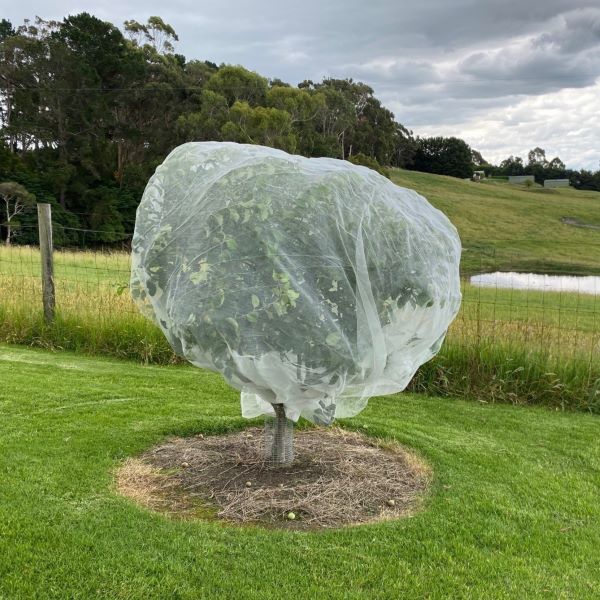The gardening journey brings some challenges along the way, one such challenge is protecting your plants from destructive pests like cabbage moths, grasshoppers, fruit flies and other insects.
These common garden pests can cause significant damage, affecting plant health and reducing yields. Using insect netting is one of the most effective ways to keep these pests at bay, along with other protective strategies.
 In this blog, we will discuss the best methods to prevent damage from common insects while ensuring your plants stay healthy and productive.
In this blog, we will discuss the best methods to prevent damage from common insects while ensuring your plants stay healthy and productive.
Common Garden Insects That Harm Plants
Before jumping into protection methods, let’s look at some of the most common garden pests/insects and their impact:
- Cabbage Moths – Lay eggs on brassica plants (cabbage, broccoli, cauliflower), leading to caterpillars that eat leaves.
- Grasshoppers – Consume large amounts of plant leaves and stems, leading to widespread destruction.
- Fruit Flies – Attack ripening fruits, laying eggs inside, causing rot and spoilage.
- Aphids – Sap-sucking insects that weaken plants and spread diseases.
- Whiteflies – Small insects that cause yellowing and wilting by sucking plant juices.
- Caterpillars – Larvae of moths and butterflies that chew through leaves and stems.
Now, let’s explore how to protect your plants from some of the worst offenders.
Protecting Plants from Cabbage Moths
Cabbage moths, also known as cabbage white butterflies, lay eggs on the leaves of brassica plants. When the eggs hatch, the larvae (green caterpillars) start feeding on leaves, leaving behind holes and damaging young plants.
Best Ways to Control Cabbage Moths
- Use Insect Netting
- Fine insect mesh netting prevents moths from landing and laying eggs on your plants.
- Use 0.4mm insect netting to effectively block cabbage moths and other flying pests.
- Cover the entire crop, securing the edges to prevent any entry points.
- Handpicking Caterpillars
- Regularly check under leaves and remove any caterpillars you find.
- Look for yellowish eggs and remove them before they hatch.
- Encourage Natural Predators
- Birds, parasitic wasps, and ladybugs feed on cabbage moth caterpillars.
- Plant flowers like dill, marigolds, and alyssum to attract these beneficial insects.
- Use Companion Planting
- Grow strong-smelling herbs like thyme, rosemary, and sage around brassicas to deter moths.
- Nasturtiums act as a trap crop, attracting caterpillars away from your vegetables.
Protecting Plants from Grasshoppers
Grasshoppers are voracious eaters, damaging leaves, stems, and even flowers. In dry seasons, they become particularly problematic as they move into gardens looking for food.
Best Ways to Control Grasshoppers
- Use Insect Netting
- Fine mesh insect netting (1mm or smaller) can block grasshoppers from reaching plants.
- Cover seedlings and young plants, as they are the most vulnerable to attack.
- Encourage Natural Predators
- Birds, frogs, and praying mantises feed on grasshoppers and can help control their population.
- Planting shrubs and tall grasses attract birds to your garden.
- Apply Organic Sprays
- Use garlic or neem oil spray on plants, as grasshoppers dislike the strong scent.
- Diatomaceous earth (DE) can be sprinkled around plants to deter feeding.
- Create a Trap Crop
- Grow a sacrificial patch of leafy greens or long grass away from your main crops.
- This encourages grasshoppers to feed on these plants instead of your vegetables.
Protecting Fruits from Fruit Flies
Fruit flies are one of the most destructive pests for fruit trees and vegetable gardens. They lay eggs inside ripening fruit, leading to rot and infestations. Queensland fruit fly and Mediterranean fruit fly are the most common species in Australia.
Best Ways to Control Fruit Flies
- Use Fruit Fly Netting
- Fruit fly netting with a fine 2mm mesh prevents flies from reaching fruits.
- Cover entire fruit trees or individual vegetable beds with netting to stop egg-laying.
- Harvest Fruits Early
- Remove ripe fruit as soon as possible to prevent fruit flies from laying eggs inside.
- Dispose of any overripe or fallen fruit to avoid attracting pests.
- Set Up Fruit Fly Traps
- Use homemade or commercial traps with vinegar or yeast bait to lure fruit flies.
- Hang traps near fruit trees or vegetable plants for early detection.
- Use Organic Fruit Fly Sprays
- Kaolin clay spray forms a protective barrier on fruit, discouraging flies from laying eggs.
- Neem oil and insecticidal soaps help reduce fruit fly populations.
Why Insect Netting is the Best Defense Against Pests
Insect netting is one of the most effective, long-term solutions for keeping pests out of your garden. Unlike chemical pesticides, it offers natural, non-toxic protection that lasts season after season.
Benefits of Using Insect Netting
- Blocks a wide range of insects, including cabbage moths, grasshoppers, and fruit flies.
- Reduces the need for chemical pesticides, promoting organic gardening.
- Protects plants from wind, sunburn, and heavy rain.
- Allows air and sunlight to pass through while keeping pests out.
- Can be reused for multiple growing seasons.
Sage Horticultural offers high-quality insect mesh netting and fruit fly netting to protect your garden. Whether you need fine mesh for tiny pests or heavy-duty netting for larger insects, we have the right solution for you.